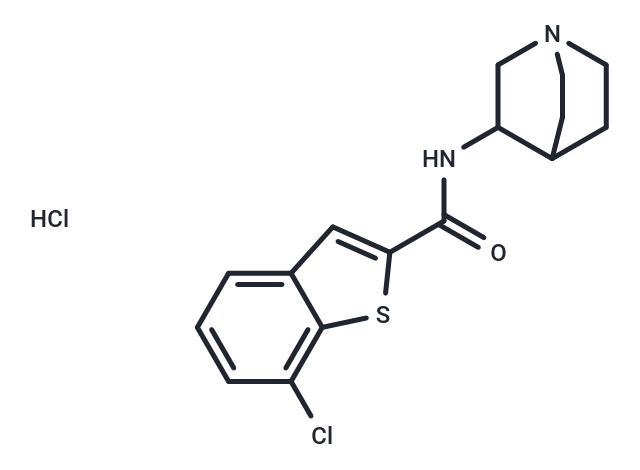Shopping Cart
- Remove All
 Your shopping cart is currently empty
Your shopping cart is currently empty

Encenicline hydrochloride (EVP-6124 hydrochloride) is a novel partial agonist of α7 neuronal nicotinic acetylcholine receptors (nAChRs).

| Pack Size | Price | Availability | Quantity |
|---|---|---|---|
| 1 mg | $54 | In Stock | |
| 5 mg | $127 | In Stock | |
| 10 mg | $198 | In Stock | |
| 25 mg | $413 | In Stock | |
| 50 mg | $662 | In Stock | |
| 100 mg | $1,050 | In Stock | |
| 1 mL x 10 mM (in DMSO) | $138 | In Stock |
| Description | Encenicline hydrochloride (EVP-6124 hydrochloride) is a novel partial agonist of α7 neuronal nicotinic acetylcholine receptors (nAChRs). |
| In vitro | EVP-6124 hydrochloride displaces [3H]-MLA (Methyllycaconitine) (Ki=9.98 nM, pIC50=7.65±0.06, n=3) and [125I]-α-bungarotoxin (Ki=4.33 nM, pIC50=8.07±0.04, n=3). EVP-6124 is approximately 300 fold more potent than the natural agonist ACh (Ki=3 μM), measured in binding assays using [3H]-MLA. EVP-6124 inhibits the 5-HT3 receptor by 51% at 10 nM, the lowest concentration tested. Evaluation of the human 5-HT2B receptor expressed in CHO cells demonstrates displacement of [3H]-mesulergine (Ki=14 nM) and only antagonist activity in the rat gastric fundus assay at an IC50 of 16 μM. In binding and functional experiments, EVP-6124 shows selectivity for α7 nAChRs and does not activate or inhibit heteromeric α4β2 nAChRs[1]. |
| In vivo | EVP-6124 hydrochloride demonstrates effective brain penetration and sufficient exposure duration, showing significant memory restoration at a dose of 0.3 mg/kg orally in scopolamine-induced memory impairment in rats, measured by an object recognition task (ORT). When combined with donepezil at sub-efficacious doses (0.1 mg/kg, orally for donepezil and 0.03 mg/kg, orally for EVP-6124), full memory restoration is achieved, suggesting synergistic effects. In a 24-hour retention natural forgetting test, EVP-6124 at 0.3 mg/kg orally enhances memory, an effect inhibited by the selective α7 nAChR antagonist methyllycaconitine, validating the involvement of α7 nAChR in the mechanism of action. EVP-6124 binds to rat plasma proteins at a moderate level with a fractional unbound average of 11% and shows dose-proportional pharmacokinetics over a 0.1-30 mg/kg oral dose range. Peak times (Tmax) are recorded at 4 hours in plasma and 2 hours in the brain, with brain concentrations maintaining from 2 to 8 hours, and brain-to-plasma (B:P) ratios ranging from 1.7 to 5.1. Additionally, at a dose of 0.4 mg/kg intraperitoneally, EVP-6124 achieves peak brain concentration in 2 hours, maintaining effective levels for at least 4 hours, and notably increases NMDAR saturation index in wild-type mice without affecting wakefulness or locomotion. |
| Kinase Assay | Binding or activity of EVP-6124 is measured at 10 μM in a selectivity panel according to standard validated protocols under conditions defined by the contractor. For the 5-HT2A receptor binding assay, membranes are prepared from HEK293 cellsexpressing the human recombinant 5-HT2A receptor. For 5-HT2B and 5-HT2C receptor binding assays, membranes are prepared from CHO cells expressing the human recombinant 5-HT2B or 5-HT2C receptor. Affinity is determined by incubating different concentrations of EVP-6124 in binding buffer for 1 h. For 5-HT2A binding, the incubation is at 22°C in the presence of 0.5 nM [3H]-ketanserin; for 5-HT2B, at 22°C in the presence of 2 nM [3H]-mesulergine; and for 5-HT2C, at 37°C in the presence of 1 nM [3H]-mesulergine. Nonspecific binding is determined in the presence of 1 μM ketanserin, 10 μM mesulergine, or 10 μM RS-102221 for 5-HT2A, 5-HT2B, or 5-HT2C, respectively. All measurements are performed in triplicate. EVP-6124 is also tested in the 5-HT2B rat gastric fundus tissue response assay. Briefly, inhibition of α-methyl serotonin-induced contraction is isometrically measured. All measurements are performed in duplicate[1]. |
| Alias | EVP-6124 hydrochloride, EVP-6124 (hydrochloride) |
| Molecular Weight | 357.3 |
| Formula | C16H17ClN2OS·HCl |
| Cas No. | 550999-74-1 |
| Smiles | Cl.Clc1cccc2cc(sc12)C(=O)NC1CN2CCC1CC2 |
| Relative Density. | no data available |
| Storage | Powder: -20°C for 3 years | In solvent: -80°C for 1 year | Shipping with blue ice. | |||||||||||||||||||||||||
| Solubility Information | DMSO: 10 mg/mL (27.99 mM), Sonication is recommended. | |||||||||||||||||||||||||
Solution Preparation Table | ||||||||||||||||||||||||||
DMSO
| ||||||||||||||||||||||||||

Copyright © 2015-2025 TargetMol Chemicals Inc. All Rights Reserved.